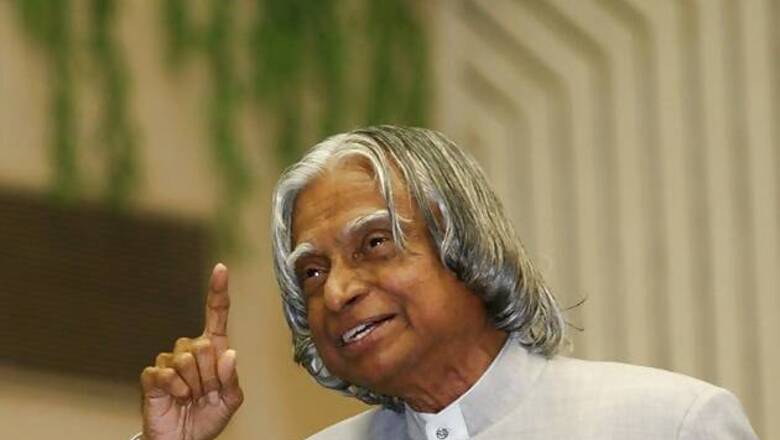
views
Aurangabad: Researchers of different faculties like medicine, engineering and pharmacy should work together for developing medical systems, devices and equipment at an affordable cost, former President APJ Kalam, said on Sunday.
Kalam was addressing the 53rd annual convocation ceremony of the Dr Babasaheb Ambedkar Marathwada University held Sunday evening. Giving example of interdisciplinary research, he said that the Raju-Kalam (KR) stent emanated through the working of a missile laboratory and a medical institution on a mission mode.
The successful mission of medical and engineering teams in developing a stent at an affordable price proved to be a boon to those who could not afford it, he said. He said that the new dimension of 21st century's knowledge society is that science, technology and environment would have to go hand-in-hand to be sustainable. A leader must have a vision, a passion to transform the vision into action and the courage to take decisions for its success, he said.
He said creative leadership means exercising the vision to change traditional roles, from commander to coach, manager to mentor, director to delegator and from one who demands respect to one who facilitates self-respect. He said that a teacher's love for research and their experience in research are vital to the growth of institutions and a university is judged by the level and extent of the research work it accomplishes.
He said that experience of research and quality teaching imparted to the youth in turn enriches the research. "Science is linked to technology through applications. Technology is linked to economy and environment through manufacturer of knowledge products. Economy and environment are linked to technology, which promotes prosperity to society. We have to use innovation to generate high value added products to become a global player," he said.
He said that those who designed the Agni missile also developed a Floor Reaction Orthosis (FRO) caliper of 400 gm for polio-affected children. "Earlier, an FRO weighing 4 kg was fitted to a child who could not run or ride a bicycle due to its weight. With our light weight device, students can run, ride a bicycle and do all sorts of things which they had been denied for a long time. The removal of pain and the freedom attained by children gave me a state of bliss, which I never experienced during any other achievement in my life," he said.
He said that he is sure that a nano robot will be used for drug delivery soon, with use of nanotechnology, microelectronics and material science in medicine. He said that nano-robots injected into a patient, would diagnose as well as deliver treatment exclusively in affected areas and it will get digested, since it would be a DNA-based product. "When nano technology and ICT meet, integrated silicon electronics and photonics are born. It can be said that material convergence will happen. When material convergence and biotechnology is linked, a new science called 'intelligent bioscience' will be born which would lead to a disease-free human habitat with longevity and high human capabilities. Convergence of bio-nano-info technologies could lead to the development of nano-robots," he said. He said that he had seen such a product sample in a South Korean laboratory.



















Comments
0 comment